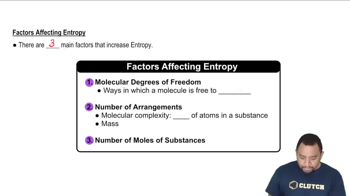Textbook Question
Predict the sign of ΔSsys for each of the following processes: (a) Molten gold solidifies.
1292
views
1
rank
 Verified step by step guidance
Verified step by step guidance



Predict the sign of ΔSsys for each of the following processes: (a) Molten gold solidifies.
Predict the sign of ΔSsys for each of the following processes: (b) Gaseous Cl2 dissociates in the stratosphere to form gaseous Cl atoms.
Predict the sign of ΔSsys for each of the following processes: (c) Gaseous CO reacts with gaseous H2 to form liquid methanol, CH3OH.
Cyclopropane and propylene are isomers that both have the formula C3H6. Based on the molecular structures shown, which of these isomers would you expect to have the higher standard molar entropy at 25 °C?